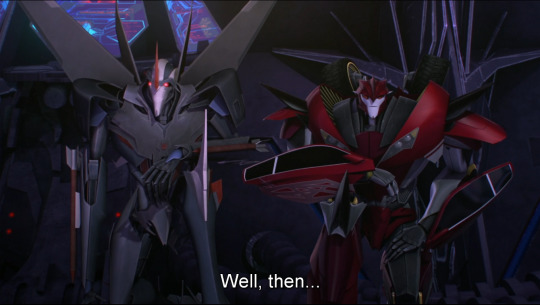#it just seems like there’s an extremely specific set of fanon rules of characterization
Explore tagged Tumblr posts
Text
Writing fic just for yourself is fully so insane I’ve got I think about 70k words of a bkdk whump fic that will never see the light of day. It’s literally like 150 pages. Just cause. Just cause the concept was rattling the bars of its enclosure and I’m a freak like that.
#the bnha fandom scares me I’m sorry IM SORRY#it just seems like there’s an extremely specific set of fanon rules of characterization#and I. do not agree with most of them#like I’ll see a post like ‘everybody KNOWS Bakugo Is lactose intolerant coded’ with like 80k notes#and I’m like..do we? do we all know that? I didn’t know that?#so I’m scared of y’all I’m sorry but sometimes it feels like we watch different shows#postcards from stupid town
4 notes
·
View notes
Note
Your post on subversion was intriguing. My friend and I were similarly wondering if fans take "fanon" too seriously as it warps their perception of "canon." As in the direction taken, be it by different writers or the same one, goes someplace fans just don't like. What makes it "bad writing" or "fans who just didn't like what they got" exactly? It can feel so... mixed up honestly.
refers to this post [X]
Thank you!!!
I think that fanon has so many definitions that it can be difficult to discuss without being specific

a not-particularly-safe-for-weenies example is Transformers fandom has a particular way of describing cybertronian genitals, in terms of their form, function, and terminology, that is widely (though not universally) used in fic, despite not being part of the established lore
that’s what happens when fanon is created to be lore-conforming but to address something that is not (or cannot be) directly discussed within the media itself

sometimes, fanon is about taking a hammer and fixing canon because it’s broken
for example, though it’s frankly the least of her problems when it comes to worldbuilding, JK Rowling can’t do math. it’s never clear how many students attend Hogwarts, but her overly simplified small number of magical schools throughout the world really shows that she just … didn’t crunch the numbers
I could go on about how to figure out proportions of mutants/wizards/vampires etc, but the issue here is that fans basically have to ignore this new lore because it’s absurd. that doesn’t mean that there’s a newly established fanon for HP international schools, but one day, there might be

sometimes, fanon takes a very different turn, when fans far and wide commonly accept what’s called “woobification“ of a character
Snape, Loki, Kylo Ren, Damon Salvatore. these are all fine characters to like if you so choose (I’m obsessed with Sheev Palpatine; I get it), but sometimes people will try to justify that fondness by pretending that the character is someone wildly divorced from their actual morality
I don’t want to talk about any given character, and inconsistent writing can also be a factor, and also not all of the characters I just listed are on equal moral footing by any means. but sometimes the fanon version of a character is unrecognizable because they’re a much better person than their canon counterpart

fandom expectations can be extremely difficult to manage and even to predict. if fans come up with their own ideas about how a story should end or what sort of dynamic a pair of characters have, that can come into conflict with what ends up happening in the story
unfortunately, there’s no single, hard-and-fast rule for what makes a good story vs what makes a bad one
in my previous post (linked to at the top of this post), I talked about how telling a good story is like setting up a marble ramp or a series of dominoes, where all of the pieces should be in place to get you to the ending you desire. if you have to flick over a second domino or pick up the marble and deposit it somewhere else – that is, force characters to do something that neither personality (marble) nor circumstances (ramp/obstacles/etc) support – then you’ve made a mistake. audiences will usually notice
sometimes, fanon ideas of who a character is can influence fans, which lead them to do the pikachu-surprise-meme when a canon portrayal remains consistent. but sometimes, there are other factors, such as a likeable actor. Alan Rickman was a good guy, but Severus Snape was not

this may seem like a tangent, and perhaps it is, but sometimes authors and other storytellers try to impose their own, incorrect, moral view of the world in their stories.
Jolkien Rolkien Rolkien Tolkien himself used Gandalf to tell the Frodo (and the reader) that it would be morally wrong to simply execute Gollum rather than kill him in self-defense or battle. this pays off later when Gollum’s avarice destroys the One Ring and saves Middle Earth (spoilers!). this only works out this way because JRRT, who is catholic, told that story, not because it’s always the case that the person whose life you spared will accidentally save the day later.
another great example is JKR declaring that Snape is a hero. I won’t get into her odd treatment of Slytherin, and this may fall under the I Will Fix Canon With Hammer type of fanon, but I think that we all know that she bent over backwards to vilify Slytherins just as she did with fat people (except the ones who were just foolish)
nothing that JKR says can make Snape a good person unless she tells us that the dialogue that he spoke and the actions described on the pages were just … lies she told us for some reason. writers can control the very laws of reality of their worlds, but right and wrong are what they are

anyway, I absolutely agree that what fans want to see can come into conflict with what the storyteller gives them, and that it can create an unfair backlash
by that same notion, sometimes storytellers will dismiss fan concerns over bad writing (inconsistent characterization, rushed storylines, etc) and blame “fan entitlement.” that’s a real thing, but it’s the people who rage angrily and lead review-bombing campaigns – not the people who hate seeing their favorite characters murdered by the writers (and sometimes, by other characters) because it was poor writing
I love-love-love Mass Effect Andromeda, but I know that some fans of the series did not. that does not make them bad fans. sending hate to a developer or to people who enjoyed it would make them a bad fan
bad fan behavior comes from actual behavior, not what they think about a piece of media
and as for telling the difference between bad writing and fans disappointed by a solid narrative? I mean, my marble example shows one part of what I think defines good vs bad writing. mostly, we just have to figure out for ourselves if a choice made us sad or if it was actually bad
#writing#fanon#storytelling#I hope that this is helpful anon sorry that it's so long#anon ask#anon#ask
5 notes
·
View notes
Text
The Three Faces of Fanon Sendak (and Why They Have No Basis in Canon)
Modern fandom loves a monster. More accurately, fandom loves to take characterizations to the extreme. Protagonists become innocent angels who can do no wrong; antagonists, regardless of canon personalities and behavior, become monsters with no redeeming qualities. This is a chronic issue affecting most antagonists in the Voltron fandom–most notably Lotor, wildly mischaracterized as a misogynist and general bastard. Most mischaracterizations aren’t quite so dramatic a diversion from canon, but are more widespread as to become the fandom default. I’m not going to name names, but certain members of the Voltron community have popularized a characterization of Sendak that has no foundation in canon, which can be split into three component parts: the sociopathic bastard, the blood knight in love with his own carnage, and the abuser. And they're all wrong.
The Sociopath
Sociopath: a person with a psychopathic personality whose behavior is antisocial, often criminal, and who lacks a sense of moral responsibility or social conscience. Here is a link to the DSM criteria for antisocial personality disorder, the official designation for sociopathy in the psychology world. Feel free to peruse it at your leisure, but for now, the abbreviated version:
Impairments in self functioning: egocentrism, self-esteem derived from personal gain, power, or pleasure or goal-setting based on personal gratification, failure to conform to lawful or cultural ethical behavior. Sendak features neither of the above, stating outright that he “fight[s] for the Empire” and “conquer[s] in the name of Galra” (S1E1, 30 minutes in), and conforms to Galra ethical norms throughout his appearances.
Impairments in interpersonal functioning: lack of empathy or incapacity for mutually intimate relationships. Now, before you say anything about his treatment of Shiro, I would like to remind you that Shiro is an enemy combatant and hostage used against another enemy combatant, therefore Sendak’s interactions with him do not count toward this assessment. I would argue that we don’t have enough interactions between Sendak and other Galra to accurately assess this point.
Antagonism: manipulativeness or deceitfulness or callousness or hostility. This is another point I would argue that we lack the canon material to assess, considering that we only see Sendak in his capacity as a soldier of the Galra Empire.
Disinhibition: irresponsibility or impulsivity or risk-taking. This point we can assess from Sendak’s canon behavior, and he shows none of these traits. In fact, Sendak is characterized primarily by his adherence to duty (his persistence in retrieving the Lions, per his orders) and his capacity as a strategist (planning and executing the attack on the Castle of Lions).
Additionally, the DSM criteria requires that traits shown are present and stable across all situations and circumstances, are not normative for an individual’s stage of development, and are not due to psychological effects of a substance or medical condition. By the official criteria, we lack the criteria to categorize Sendak as a sociopath.
The Blood Knight
As an archetype, the Blood Knight is characterized by a love of fighting. In fact, nothing matters to the Blood Knight so much as a good fight–not victory, not the morals, not the motives of their allies, not even the glory, a Blood Knight just wants to throw down and wreak as much havoc as possible.
This is in direct opposition to Sendak’s canon characterization. As stated above, the hallmarks of his personality are his dedication to duty and his capacity as a strategist, and a significant portion of his strategy is limiting collateral damage. In chronological order, he: announces his intents and purposes to Team Voltron and provides them an opportunity to surrender peacefully and accepts an apparent surrender, fires only on the Castle and Voltron during his assault from the cruiser, and, most notably, targets only the Castle’s power source and takes Shiro and Lance prisoner during his takeover.
These last two are the most significant given the circumstances they occured under. Sendak had limited resources and a small window of opportunity to take the Castle, and to cause the most damage and put more of his enemies out of commission, he could have easily had Haxus set the bomb drone off in the Castle ballroom, where most of the Paladins were at the time, rather than specifically targeting the crystal on the bridge. Additionally, killing Lance and Shiro when he took the Castle would have eliminated two potential risk factors once inside, and would have been a reasonable course of action to force Pidge into turning herself over after she killed Haxus.
In fact, the only evidence for this characterization was his willingness to fight Shiro at the Castle entrance, and even then he allowed Shiro an opportunity to stand down and surrender before engaging him in combat. Sendak is, clearly, not a Blood Knight.
The Abuser
This is, hands down, the worst and most popular fanon characterization of Sendak. It’s literally everywhere, even in fics that don’t feature Sendak as a major character–I challenge you to find a Shiro-centric fic set in the canon universe that doesn’t feature Sendak as one of the people who hurt him during his time as a Galra prisoner–and is a particular staple of Shendak as a pairing. While I acknowledge that captor/prisoner dynamics are decidedly unhealthy in a relationship, it’s too common in AU to not be part of popular fanon characterization, and I have to ask: what the fuck is up with that?
Again, before anyone brings up Sendak’s canon interactions with Shiro, I remind you that Shiro is an enemy combatant, and therefore would not be treated the same way a peer or subordinate would be. However, these interactions need to be addressed to analyse the fanon characterization, so we’ll take the plunge.
The first direct interaction between the two is the fight outside the Castle of Lions, during which Sendak and Shiro appear almost evenly match and come to a stalemate that only ends when Haxus threatens Lance, distracting Shiro and allowing Sendak to gain the upper hand and knock Shiro out. Sendak seems to view Shiro as a worthy opponent–in fact, the whole fight is frame to show them as equals in battle–but is more than willing to use his more advanced prosthetic and Haxus’s well-timed distraction to gain the upper hand and defeat him. No pun intended.
The other three notable interactions, which I suspect are the root of the characterization, are his torture of Shiro to force Pidge to surrender, his verbal beatdown between Haxus’s death and Team Voltron retaking the Castle, and the breaking speech delivered in S1E9. Again, circumstances are important in assessing a character, and the only one I would argue might be an indication of abusive tendencies is the verbal beatdown in S1E5. The torture is brief, designed to guilt Pidge into surrendering to spare her companions, and could easily have been inflicted on Lance instead of Shiro. It was a means to an end, and the intended target was an enemy combatant. Similarly, the speech in S1E9–if that was, in fact, Sendak addressing Shiro and not the Castle using his voice to mess with Shiro–was against an enemy combatant and a means to an end, though what end we cannot know considering that Shiro panicked and spaced him. As for the beatdown in S1E5…there really isn’t an explanation for it, outside of Sendak venting his frustration on the only available target–Shiro. Not really an indication of anything except how worked up he is at that moment, and do note that he doesn’t so much as invade Shiro’s personal space as he does so.
Additionally, if you want an assessment of Sendak’s interactions with an ally and subordinate: Haxus. Sendak can be a little abrupt at times, but he also praises Haxus for good ideas and jobs well-executed, which does not indicate abuse of subordinates. So…the canon ‘evidence’ for Sendak as an abuser really isn’t much evidence at all.
In Conclusion
Fandom’s favorite monster is a baseless entity, with no foundation in Sendak’s canon characterization. He does not fit the DSM criteria for a sociopath. He does not fit the archetype of the Blood Knight, nor does he display a love for carnage. And canon holds no evidence for Sendak as an abuser that holds up under fire.
I am not going to tell you how to write Sendak. I won’t say my characterization of him is definitively canon, or that you should strive to emulate it. I certainly won’t suggest you paint him as a ‘cinnamon roll’ or imply that he’s innocent of all wrongdoing–Sendak is a commander of a military force, he undoubtedly has the capacity to kill when the situation calls for it. I will suggest, however, that you consider your characterization more carefully, and that you check that it lines up more closely with the canon one. A good rule of thumb: if placing your characterization of a canon character in the same situation as the canon character would result in a different outcome to the situation, you need to rework your characterization.
#voltron#meta#salt#characters and characterization#sendak#hahaha. haha. ha.#can you tell ive had it up to here with this characterization?#feel free to debate me on this; but thats what canon has to say
142 notes
·
View notes